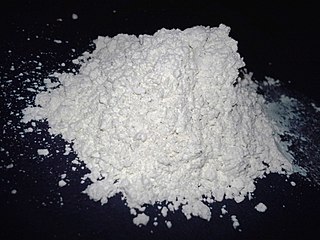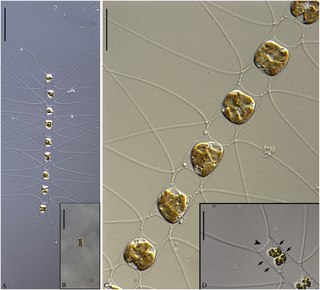
Diatomic molecules are molecules composed of only two atoms, of the same or different chemical elements. If a diatomic molecule consists of two atoms of the same element, such as hydrogen or oxygen, then it is said to be homonuclear. Otherwise, if a diatomic molecule consists of two different atoms, such as carbon monoxide or nitric oxide, the molecule is said to be heteronuclear. The bond in a homonuclear diatomic molecule is non-polar.

A diatom is any member of a large group comprising several genera of algae, specifically microalgae, found in the oceans, waterways and soils of the world. Living diatoms make up a significant portion of the Earth's biomass: they generate about 20 to 50 percent of the oxygen produced on the planet each year, take in over 6.7 billion tonnes of silicon each year from the waters in which they live, and constitute nearly half of the organic material found in the oceans. The shells of dead diatoms can reach as much as a half-mile deep on the ocean floor, and the entire Amazon basin is fertilized annually by 27 million tons of diatom shell dust transported by transatlantic winds from the African Sahara, much of it from the Bodélé Depression, which was once made up of a system of fresh-water lakes.

Diatomaceous earth, diatomite, celite or kieselgur/kieselguhr is a naturally occurring, soft, siliceous sedimentary rock that can be crumbled into a fine white to off-white powder. It has a particle size ranging from more than 3 mm to less than 1 μm, but typically 10 to 200 μm. Depending on the granularity, this powder can have an abrasive feel, similar to pumice powder, and has a low density as a result of its high porosity. The typical chemical composition of oven-dried diatomaceous earth is 80–90% silica, with 2–4% alumina, and 0.5–2% iron oxide.

Bacteriastrum is a genus of diatoms in family Chaetocerotaceae. There are more than 30 described species in genus Bacteriastrum, but many of these are not currently accepted, and new species are still added to the genus. The type species for the genus is Bacteriastrum furcatum Shadbolt.
Craspedodiscus elegans is a species of diatoms in the genus Craspedodiscus. It is the type-species in the genus.
Cymbella elegans is a diatom species in the genus Cymbella.
C. inelegans may refer to:
Campylodiscus elegans is a species of diatoms in the family Surirellaceae.
Climacosphenia elegans is a species of marine pennate diatoms in the order Fragilariophyceae.
Craspedoporus elegans is an extinct marine species of diatom from a deposit from Oamaru, Otago, New Zealand.
Coscinodiscus elegans is a species of diatom in the family Coscinodiscaceae. It is found in the Gulf of Mexico.
Cocconeis elegans is a species of diatom. It is found in Sicily.
Corinna is an extinct genus of diatoms of uncertain placement within Bacillariophyceae. C. elegans is from the Cretaceous of Canada.

Chaetoceros elegans is a species of diatom in the family Chaetocerotaceae. According to Li, 2017, the type locality is Dapeng Bay, Guangdong Province, P. R. China.
Cladomphalus elegans is a species of diatom of uncertain affinity. It is found in Jacob Whitman Bailey's collection on a slide with the inscription "Monterey, California; lower stratum".
Amphora elegans is a species of diatoms found in Europe.
Denticula elegans is a species of diatoms in the family Bacillariaceae.
Gomphoneis elegans is a species of diatoms in the family Gomphonemataceae.
Eunotia elegans is a species of diatom. It is found in Denmark.
Surirella elegans is a species of freshwater diatoms in the family Surirellaceae.




